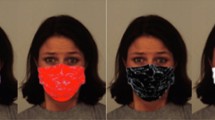Abstract
Aim
To analyse the effect of colours on children's emotions and variations in anxiety levels using six different coloured attires, white, pink, yellow, green, purple and black.
Methods
Seventy-two children aged between 5–9 years old who had come for restorative treatment in the Department of Paediatric and Preventive Dentistry, I.T.S. Dental College, Muradnagar, Ghaziabad, India were chosen and divided according to Corah’s dental anxiety scale into 4 levels of anxiety. Eighteen children from each level were then assigned six different colours (3 children for each colour). A two factor study was conducted to determine the influence of colours, anxiety levels or facial expressions on oxygen saturation levels and pulse rate of the children. Data was analysed using SPSS 16.0 for ANOVA.
Results
There was significant difference between colours influencing oxygen saturation levels (p = 0.001) and pulse rate (p = 0.038). A post-hoc test indicated that black colour was significantly different from most of the other colours. No interaction effect was found to exist between colours and facial expression.
Conclusions
Data suggested that yellow, pink and purple colours may have reduced anxiety among children whereas black colour could have enhanced it.


Similar content being viewed by others
References
Annamary K, Prathima GS, Sajeev R, et al. Colour preference to emotions in relation to anxiety level among school children in Puducherry—a cross-sectional study. J Clin Diagn Res. 2016; 10(7): ZC26–ZC30.
Asokan A, Kambalimath HV, Patil RU, et al. A survey of the dentist attire and gender preferences in dentally anxious children. J Indian Soc Pedod Prev Dent. 2016;34:30–5.
Bajric E, Kobaslija S, Huseinbegovic A, et al. Factors that determines child behaviour during dental treatment. Balk J Dent Med. 2016;20:69–77.
Bosch SJ, Cama R, Edelstein E, et al. The application of color in health settings. Concord CA: The Center for Health Design; 2012. pp. 1–78.
Boyatzis CJ, Varghese R. Children’s emotional association with colors. J Genet Psychol. 1993;155:77–85.
Faber B. Color psychology and color therapy: a factual study of the influence of color on human life. 2nd ed. New York: McGraw Hill Book Company; 1950. p. 284.
Goldstein K. The organism. Brain. 1939;62(3):335–7.
Goldstein K. Some experimental observations: the influence of colors on the functions of the organism. Am J Phys Med Rehabil. 1942;2:147–51.
Hotwani K, Sharma K. Assessment of the impact of colors on child’s anxiety and treatment preference for local anesthesia injections. JoAOR. 2017;8(1 &2):42–6.
Mittal R, Sharma M. Assessment of psychological effects of dental treatment on children. Contemp Clin Dent. 2012;3:2–7.
Park JG. Color perception in pediatric patient room design: healthy children vs. pediatric patients. HERD. 2009;2:6–28.
Sadana G, Grover R, Mehra M, et al. A novel ChottaBheem-Chutki scale for dental anxiety determination in children. J Int Soc Prev Communit Dent. 2016;6(3):200–5.
Tiwari N, Tiwari S, Thakur R, et al. Evaluation of treatment related fear using a newly developed fear scale for children: “Fear assessment picture scale” and its association with physiological response. Contemp Clin Dent. 2015;6(3):327–31.
Umamaheshwari N, Sharath A, Thanga KS. Child friendly colors in a pediatric dental practice. J Indian Soc Pedod Prev Dent. 2013;31(4):225–8.
Acknowledgements
Special Thanks to Dr (Mrs) Gopa Karmakar and Dr (Mrs) Alka Sabharwal for the statistical analysis of the study and to Dr Shrey Nandi for his valuable suggestions and encouragement.
Funding
There is no funding.
Author information
Authors and Affiliations
Corresponding author
Ethics declarations
Conflict of interest
Dr. Smriti Karmakar declares that she has no conflict of interest. Author Dr. Shivani Mathur declares that she has no conflict of interest. Author Dr. Vinod Sachdev declares that he has no conflict of interest.
Ethical approval
All procedures performed in studies involving human participants were in accordance with the ethical standards of the institutional and/or national research committee.
Research involving human participants and/or animals
Research involves human participants.
Informed consent
Informed consent was taken from all the participants.
Rights and permissions
About this article
Cite this article
Karmakar, S., Mathur, S. & Sachdev, V. A game of colours, changing emotions in children: a pilot study. Eur Arch Paediatr Dent 20, 377–381 (2019). https://doi.org/10.1007/s40368-018-0403-3
Received:
Accepted:
Published:
Issue Date:
DOI: https://doi.org/10.1007/s40368-018-0403-3




